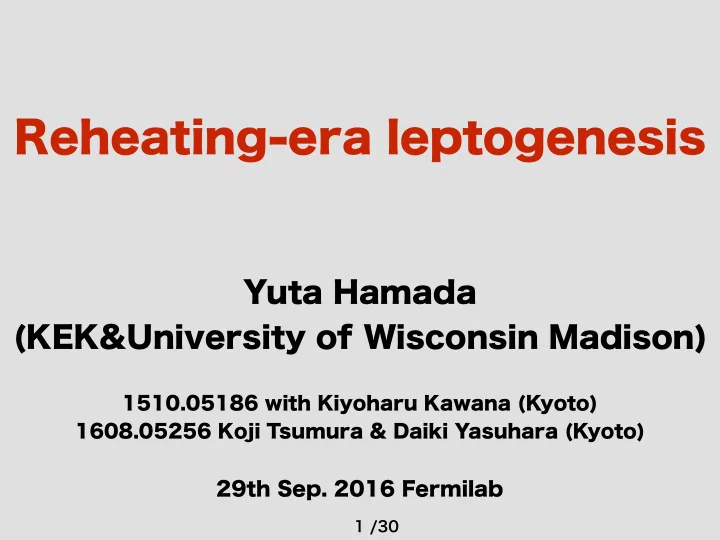

Reheating-era leptogenesis Yuta Hamada (KEK&University of Wisconsin Madison) 1510.05186 with Kiyoharu Kawana (Kyoto) 1608.05256 Koji Tsumura & Daiki Yasuhara (Kyoto) 29th Sep. 2016 Fermilab 1 /30
Higgs boson 2 /30 • M H =125GeV. • consistent with SM prediction. • SM is completed.
Baryogenesis 3 /30 There remains mystery in particle physics. • We do not understand • dark energy • dark matter • why energy density of atom is • so large(baryon asymmetry)
Sakharov’s three conditions 4 /30 1. Violation of baryon number 2. Violation of C and CP Initial state : C and CP symmetric • Final state : C and CP asymmetric 3. Out of thermal equilibrium otherwise inverse process exists. •
Leptogenesis ★ 5 /30 • One of simplest scenarios : Leptogenesis Asymmetry by decay of RH neutrino RH ν is produced in thermal plasma for T R ≳ M R • [’86 Fukugita, Yanagida] by inflaton decay for m inf ≳ M R [’91 Lazarides, Shafi] Our work Asymmetry by scattering between lepton and Higgs at reheating era [‘15 YH Kawana]
Plan 6 /30 1. Leptogenesis at reheating-era 2. seesaw models
Plan 7 /30 1. Leptogenesis at reheating-era 2. seesaw models
Setup : Action 8 /30 • Assume the existence of inflaton other than SM. • Introduce following dim5 and 6 operators. [‘97 Aoki and Kawai] LH ν Majorana mass UV Model dep. Λ 1 ~ 10 14-15 GeV If type-I seesaw Λ 2 ~ 10 15-16 GeV(later). For λ 1 =1 and m ν =0.1eV. • Inflaton sector is characterized by reheating temperature T R , inflaton mass m inf and branching ratio of inflaton to L, Br L .
Intuitive explanation 9 /30 • before the reheating process is completed. • Collision between lepton in thermal plasma and one by inflaton decay. LL → ΦΦ by • • B is mainly produced @time reheating is just completed. [Kolb, Turner]
10/30 Sakharov’s three conditions 1. Violation of baryon number • L-number violation + sphaleron process → B-violation
Sakharov’s three conditions 11/30 2. Violation of C and CP Coupling λ 1 becomes real by unitary • transformation λ 2 can have complex phase •
Sakharov’s three 12/30 conditions 3. Out of thermal equilibrium • After reheating, all SM particles are in thermal plasma. • At the era of inflaton domination, universe is out of equilibrium. L Φ Decay of inflaton E~m inf inf → X + L L Φ Thermal plasma L asymmetry E~T R
Rough estimation 13/30 • The rough estimation of asymmetry T R : reheating temperature Inflaton abundance m inf : inflaton mass
Rough estimation 14/30 • The rough estimation of asymmetry Branching ratio of inflaton to leptons
Rough estimation 15/30 • The rough estimation of asymmetry Probability that lepton violation interaction occurs before L loses energy E~m inf L Φ L vs Φ L L violation Thermalized w/o L violation [‘13 Harigaya, Mukaida]
Rough estimation 16/27 • The rough estimation of asymmetry L Φ interference between L Φ tree and one-loop
Numerical calculation 17/30 • Boltzmann equation for first contribution Friedmann eq radiation energy lepton asymmetry high energy(~m inf ) lepton inflaton energy Γ wash : washout rate n L : lepton asymmetry n l : high energy(~m inf ) lepton
Numerical Result 18/30 [‘15 YH, Kawana] • dashed : Λ 2 =10 15 GeV solid : Λ 2 =10 14 GeV
Plan 19/30 1. Leptogenesis at reheating-era 2. various seesaw models
Origin of higher dimensional operator 20/30 • origin of dimension 5 & 6 operators • seesaw models • type-I, (-II, -III), tree-level seesaw • Ma model, radiative seesaw
type-I seesaw 21/30 • Lagrangian
type-I seesaw 22/30 • dim-5&6 terms • Casas-Ibarra R is complex orthogonal matrix
type-I seesaw 23/30 • We can see Λ 1 ~ 10 14-15 GeV for m ν =0.1eV, Λ 2 ~ 10 15-16 GeV for m ν =0.1eV & R=1-10.
Parameter region 24/30 • type-I investigate region where BAU can be generated parameters: T R , m inf , M R, R, Br, CP phase Take or to maximize the asymmetry
Figure: type-I seesaw 25/30 [‘15 YH, Tsumura, Yasuhara] Br=1, CP phase=1 are taken Almost same result is obtained for inverted mass ordering case.
Ma model(radiative seesaw) 26/30 • Lagrangian, ν mass is radiatively generated.
Ma model(radiative seesaw) 27/30 y I → y M , M R → M Reff • • We can see Λ 1 ~ 10 14-15 GeV for m ν =0.1eV, Λ 2 ~ 10 13-15 GeV depending on parameters.
Parameter region 28/30 • Ma model region where BAU can be generated parameters: T R ,m inf ,M R, R 2 / λ 5 , Br, CP phase Take or to maximize the asymmetry
Figure: Ma model 29/30 [‘15 YH, Tsumura, Yasuhara] Br=1, CP phase=1, R=1 are taken
30/30 Summary • We propose the new way to produce BAU. • Even if RH ν is not produce in the early universe, the baryon asymmetry can be explained. • Embedding in seesaw models are discussed.
Recommend
More recommend